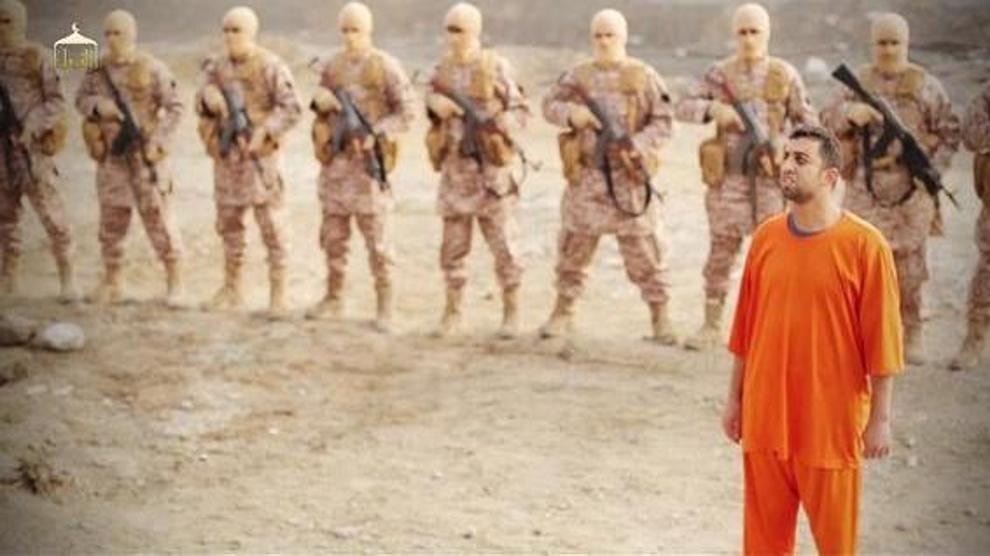In a new execution video released by the Islamic State group on Tuesday, showing the brutal In the recent video depicting the Feb. 3 execution of a captive Jordanian air force pilot, the militants are clad in matching uniforms bearing some similarity to those worn by U.S. Marines — a development that raises questions about their logistics and the image they want to convey.
The video, which appears to show the death of Jordanian air force pilot Muath al-Kaseasbeh, released online Tuesday includes imagery of During the highly theatrical video several men standing near a cage containing the captive. The lieutenant Jordanian pilot Lt. Muath al-Kaseasbeh. He was captured in December after his plane crashed during a bombing run against Islamic State targets in Syria.
The digital desert camouflage the militants are wearing wear resembles the pattern licensed to the U.S. Marine Corps. It's known as MARPAT, which is short for "Marine Pattern." But over the past decade, although similar patterns have become widely available over the past decade, according to private intelligence and policy analysts.
"That pattern has been replicated all around the world," said Ben Connable, a retired Marine intelligence officer and international policy analyst for Rand Corp. "It is easy to come by and replicate without a license just about anywhere."
While the pattern is close to a Western design, the cut of militants' blouses — which fall near the knee — is anything but. It is more similar to nonmilitary garb worn by insurgents in Iraq. That raises the possibility that the uniforms were made to order for the Islamic State, rather than purchased from a general manufacturer or pilfered from a conventional military force.
"They could get them from a manufacturer in Pakistan," Connable suggested.

While Islamic State militants wore matching uniforms on camera, experts say it's unlikely they'll appear that way on the battlefield.
Photo Credit: Screen shot
Beyond that, determining specifically where the uniforms came from is nearly impossible, Connable said. A private intelligence analyst with expertise in geopolitics — to include the conflicts in Iraq and Syria — agreed.
"Even if you were able to determine what specific camouflage pattern is represented, you wouldn't necessarily be able to determine with certainty where it came from," said another analyst who spoke with Military Times on the condition of anonymity. "The proliferation of the Internet has made it such that anyone can essentially go online and order whatever digital camouflage pattern they want. That makes it really difficult to draw any conclusions on how or where the ISIS members may have secured such gear with this pattern."
Connable said the ISIS militants seem to be One thing both Connable and others agreed on, however, was that trying to portray themselves as a cohesive, disciplined, well-funded force to be reckoned with.
The move is likely meant to fit into the theatrics of the shocking and grisly, while professionally produced, video. The group is It is more likely than not all part of the theatrics associated with the shocking and grizzly, but professionally produced, execution videos IS generates. They are careful in its their selection of location and how they stage executions for maximum shock value. So it is no surprise that they want to appear as organized as possible on camera, Connable said.
The ther intel analyst echoed that sentiment. him.
"The ISIS members seem to be trying to portray a level of professionalism that comes from a group having standardized uniforms," the analyst said. "In this case, consider the overall propaganda value at play -— that this is a cohesive, well-trained group of soldiers ... an image that a standardized uniform can help convey."
Still, Connable said it's unlikely that that will extend beyond video as it would be That is not the reality and Connable said it is both impractical for ISIS to and unlikely that IS will adopt a standard uniform for use on the battlefield.
"Their guys in the field are wearing 'mix-and-match,'" he said. "They are recruiting them locally, smuggling them across the border, so that makes it difficult. Any Marine will tell you keeping uniforms on people in field for extended periods of time takes a real supply chain."
While Connable described it as "pure conjecture" the new uniforms seen in the video could also indicate a move to field standard uniforms to an elite unit or inner-guard within IS.
Al-Kaseasbeh is the first and only pilot captured by the group during coalition operations against the group. The Jordanian government entered talks with ISIS to trade Sajida al-Rishawi, an Iraqi female suicide bomber who participated in a 2005 hotel bombing in Jordan, for al-Kaseasbeh. But in retaliation for his murder Jordan is now discussing plans to execute her Wednesday.










